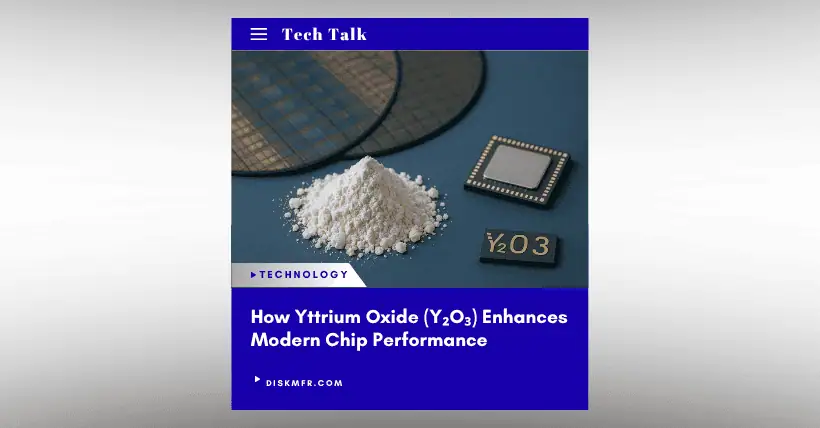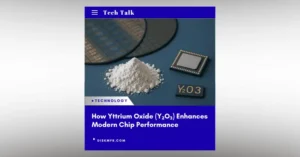1. Summary (Conclusion First)
Yttrium oxide (Y₂O₃) is one of the most critical protective materials for modern plasma etching chambers. It offers exceptional chemical stability and erosion resistance in high-energy ion and halogen plasma environments, significantly extending maintenance intervals, reducing particle contamination, and improving equipment utilization. In advanced logic and memory fabs (below 7 nm nodes), Y₂O₃ coatings have gradually replaced traditional anodized aluminum parts, becoming a key material supporting equipment performance and process yield.
2. Application Scenarios / Boundaries about Yttrium Oxide
| Dimension | Description |
|---|---|
| Process Type | High-density plasma etching (ICP/CCP), media such as CF₄, SF₆, O₂, Cl₂, HBr |
| Equipment Area | Inner chamber walls, liner, baffle, showerhead, ESC outer protective parts |
| Main Function | Prevent etching/sputtering of substrates (aluminum, quartz, etc.); reduce metal/halogen contamination |
| Implementation Scope | Does not involve electrical components; limited to plasma-exposed protective parts |
3. Technical Assessment and Mechanism Explanation
- Why choose Y₂O₃
- High chemical stability: High Y–O bond energy, highly resistant to halogen (F, Cl) corrosion.
- Low particle generation: Dense coating resists peeling or forming oxide/fluoride debris.
- Strong thermal stability: Maintains structural integrity above 1000 °C, resistant to thermal cracking.
- Comparison with traditional anodized aluminum (Al₂O₃)
| Item | Anodized Aluminum | Yttrium Oxide (Y₂O₃) |
|---|---|---|
| Chemical Stability | Moderate, prone to halogen corrosion | Extremely high, virtually inert |
| Particle Contamination Risk | Easily forms AlF₃ flakes | Extremely low |
| Chamber Lifespan | Hundreds of hours | Thousands of hours |
| Cost | Low | Higher, but better lifecycle cost |
4. Value Logic (Key to PM)
| Dimension | Impact Point | Product Manager Focus Point |
|---|---|---|
| Yield | Reduces particle defects (killer defects) | Product differentiation: % reduction in particles |
| Utilization | Extends PM intervals | Quantifiable OEE improvement for customers |
| Material Alternatives | Performance gradient with YF₃, YAlO₃, Al₂O₃ | Build product portfolio structure (basic/high-end) |
| Supply Chain | Integrated capabilities from powder to coating | Evaluate supply chain maturity and domestic substitution progress |
| Regulations & Cleanliness | High-purity powder processes must meet SEMI C10/C79 | Used as certification barrier and competitive edge |
5. Material Selection in Three Steps (From a Product Perspective)
- From purity to structural consistency
Evaluate not only “5N” purity but also impurity spectrum (Na/K/Cl/F/C) and inter-batch stability. - From composition to sprayability
Powder must undergo spray granulation + sintering to form high-sphericity agglomerates; otherwise, powder delivery or melting is unstable. - From powder to coating system verification
Check final coating microstructure, porosity, hardness, adhesion strength, and plasma corrosion resistance data.
6. Key Indicators from PM Perspective (For Product Definition or Bidding)
| Category | Indicator | Meaning |
|---|---|---|
| Powder | Particle size distribution D10/D50/D90, consistency Cpk, sphericity | Determines sprayability and deposition efficiency |
| Impurities | Na/K/Fe/Cl/F/C/H₂O levels | Determines corrosion and contamination risk |
| Coating | Porosity, microhardness, adhesion strength | Affects corrosion resistance and lifespan |
| Reliability | Particle generation rate, PM interval improvement ratio | Reflects real customer benefit |
7. Risks and Introduction Strategies
| Risk | Description | Countermeasure |
|---|---|---|
| Hollow particles / powder decomposition | Leads to high porosity, easy peeling | Require SEM inspection + TGA confirmation of full degreasing |
| Inter-batch variation | Fluctuations in particle size/flowability | Supplier must provide batch Cpk report |
| Chamber edge wear | Localized sputtering intensification | Optimize thickness distribution and interlayer design |
| Halogen etch grooves | Impurity or grain boundary weakening | Control halogen content ≤ detection limit |
| Cost pressure | Expensive raw materials | Emphasize LCC advantage and PM interval ROI |
8. Supply Chain and Market Trends (PM Focus)
- Global Landscape: Tosoh, H.C. Starck, and Showa Denko are key players in high-end powder; Japanese suppliers lead in powder preparation and coating consistency.
- Domestic Substitution: Some Chinese companies have mastered spray granulation and densification, but still need improvement in impurity control and batch consistency.
- Application Extension: Beyond etching chambers, Y₂O₃ is also used in MOCVD chamber protection, PVD target additives, and CMP polishing aids.

Disclaimer:
- This channel does not make any representations or warranties regarding the availability, accuracy, timeliness, effectiveness, or completeness of any information posted. It hereby disclaims any liability or consequences arising from the use of the information.
- This channel is non-commercial and non-profit. The re-posted content does not signify endorsement of its views or responsibility for its authenticity. It does not intend to constitute any other guidance. This channel is not liable for any inaccuracies or errors in the re-posted or published information, directly or indirectly.
- Some data, materials, text, images, etc., used in this channel are sourced from the internet, and all reposts are duly credited to their sources. If you discover any work that infringes on your intellectual property rights or personal legal interests, please contact us, and we will promptly modify or remove it.








